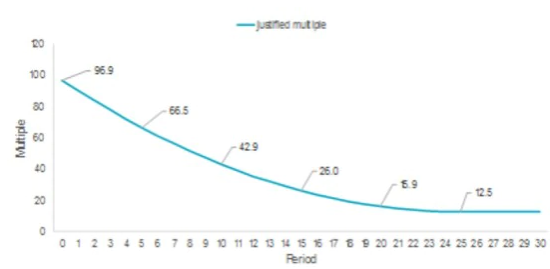A reason for many investors not to invest in high-quality, high growth-companies is that the shares of these companies usually command high valuation multiples and, consequently, almost always look expensive. To see whether these ostensibly high multiples are justified or not, investors need to carefully consider the different underlying drivers of equity value that are obscured by the use of a simple multiple. In the vast majority of cases, high multiples are a fair reflection of strong underlying business fundamentals.
Two components of firm value
In a classic article, Miller and Modigliani [1961] showed that the value of a firm consists of two components:
the steady-state value of existing assets
future value creation
The steady-state value assumes that the current assets produce a level of normalized profits indefinitely into the future. This steady stream of future profits can be valued as a perpetuity; i.e. normalized profit divided by the cost of capital. The appropriate multiple to pay for the steady state value of a business therefore is the reciprocal of the cost of capital.
Get the latest insights
Subscribe to our newsletter for investment updates and expert analysis.
Three fundamental factors drive future value creation
By construct, the steady state describes a situation in which incremental investments earn the cost of capital and, consequently, do not create economic value. Higher multiples than this steady-state multiple can only be justified by future value creation, which is determined by three fundamental factors:
investment returns that exceed the cost of capital (‘earn a positive spread’)
the relative size of profitable investment opportunities
the duration of the competitive advantage
In line with these factors, there are three situations in which paying a high multiple is justified:
The higher the difference (spread) between the cost of capital and the returns on incremental investments, the higher the justified multiple.
There has to be a set of investment opportunities that is sufficiently large in comparison with the capital already invested in the business. In general, young businesses with large and growing markets will therefore trade at higher multiples than old businesses with limited markets.
The longer a competitive advantage lasts, the higher the justified multiple. The competitive advantage period (CAP) is a function of the nature of the competitive advantage; industry characteristics; and management’s agility to create and capture strategic options for new growth initiatives. As a rule, mature companies have more strategic options to extend their CAP than younger companies.
Getting a feel for what is a justified multiple
Investors can develop a 'feel' for what constitutes a justified multiple by playing around with the framework of Miller and Modigliani. A very useful exercise is to plot a company life cycle multiple trajectory as in the figure below.
The multiple trajectory of a fictitious company through time

The figure shows the theoretical multiple trajectory of a company that starts out with a positive spread of 25% over its 8% cost of capital, eroding by 1% each year in which its competitive advantage period lasts. Assuming perfect foresight, investors should be willing to pay a seemingly astronomical multiple of 96.9 at the start of this company’s life. The high multiple is justified by the prospect of 25 years of profitable, value creating growth ahead. As the company moves through time and steadily consumes its growth opportunities, the justified multiple slowly converges to the steady-state multiple of 12.5 (1/8% after 25 years).
This example shows that it makes perfect sense to pay a high multiple for a company that has a long and bright future of value creation ahead of it. At the same time, mature companies with few remaining opportunities for value creation should be valued at multiples much closer to the steady state.
Open your portfolio to the power of themes
For over 25 years, Robeco has been a pioneering leader in constructing thematic strategies.
Two very common but dubious valuation practices
The life cycle perspective also exposes as dubious the common practice of using average historical multiples for estimating what a reasonable multiple is. Given the downward-sloping shape of the justified multiple trajectory through time, extrapolating from historical averages can easily lead to an upward bias in valuation.
Another ubiquitous practice is comparing the multiples of two companies without properly accounting for differences in underlying fundamentals. This usually involves comparing multiples and projected earnings growth without properly examining what is driving the earnings growth. Earnings growth is not always synonymous with value creation.

Steef Bergakker
Portfolio Manager
“
Markets are pricing assets efficiently most of the time
Market inefficiency is a relatively rare occurrence
Investors with a strong tendency to view high-multiple firms as overvalued, are implicitly assuming that financial markets are biased most of the time and that they are therefore inefficient. While it is undoubtedly true that markets sometimes do get carried away and periodically price (groups of) assets inefficiently, it is a relatively rare occurrence, as strongly suggested by the difficulty of systematically beating the market.
Of course, the expectations on which the underlying fundamentals are based can turn out to be inaccurate. However, inaccurate expectations are something different than biased expectations. If highly inaccurate expectations hit the mark on average, they are still unbiased and not indicative of inefficient pricing. In contrast, if expectations are consistently too high or low, they are biased, even if they are on average fairly accurate (i.e. close to the mark). We contend that market expectations may be inaccurate, sometimes highly so, but largely unbiased in their expectations of underlying fundamentals. This view implies that markets are pricing assets efficiently most of the time and that multiples reflect underlying fundamentals in the vast majority of cases.
